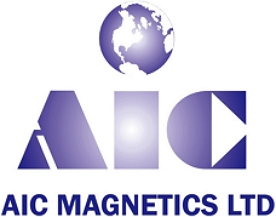Permanent Magnets
-
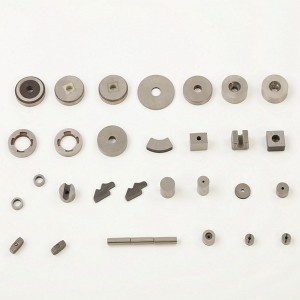
AlNiCo Magnets
AlNiCo magnets are a sophisticated alloy primarily composed of aluminum, nickel, cobalt, copper, and iron. It is available in two distinct forms: cast and sintered, each shaped by unique manufacturing processes. The cast AlNiCo magnets possess exceptional hardness and brittleness. Consequently, machining or drilling is not possible through conventional methods. The casting process usually entails the creation of holes at the foundry. The magnets are cast or sintered as closely as possible to the desired size, effectively minimizing the need for abrasive grinding to achieve the specified dimensions and tolerances.
-
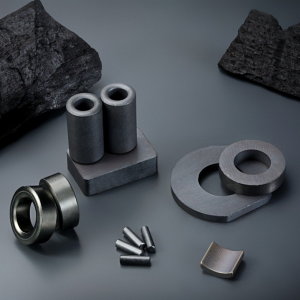
Hard Ferrite Magnets
Sintered ferrite magnets encompass two primary variants: Barium Ferrite and Strontium Ferrite, each featuring different orientations, classified as isotropic and anisotropic. These magnets are crafted through a high-temperature sintering process, akin to the production of ceramics. They exhibit a hard and brittle texture, characteristic of their composition.
Over the course of more than five decades, sintered ferrite magnets have undergone significant development to become the most prolifically manufactured permanent magnets globally. Their widespread use spans across numerous industries, including electric motors, magnetic separators, loudspeakers, hearing aids, office supplies, educational tools, and children’s toys.
The appeal of sintered ferrite magnets lies in their attractive balance between cost-effectiveness and moderate magnetic performance. This unique combination positions them as versatile and reliable components in various applications, delivering a cost-efficient magnetic solution while satisfying the demands of specific engineering requirements.
-
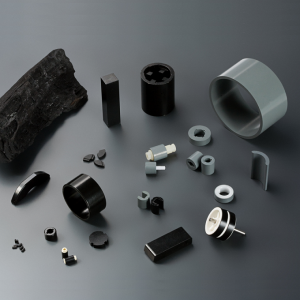
Bonded Magnets
Bonded magnets are a unique class of magnetic materials formed by blending magnetic powder with a binding agent. This blend is precision-molded under controlled pressure and subsequently cured at temperatures ranging from 150 to 175°C. The resulting magnet’s shape and dimensions are determined by the mold, enabling one-step production without the need for secondary machining. These magnets boast several key advantages, including exceptional magnetic performance, precise dimensional consistency, versatility in shaping, excellent resistance to corrosion, multiple magnetization options, and suitability for large-scale production, ensuring elevated manufacturing efficiency.
-
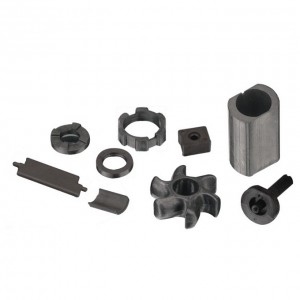
Injection Molded Magnets
Injection molded magnets, often referred to as molded composite magnets, represent a class of advanced materials formed by blending thermoplastic resin with magnetic powder. This unique amalgamation is meticulously processed under pressure, allowing it to flow into a precisely designed mold cavity. Within this cavity, the material takes on its final form, undergoes orientation, experiences a controlled cooling process, and ultimately solidifies into the desired shape. The injection molding process is capable of producing an array of intricate shapes, including thin-walled rings, rods, and complex custom geometries. Additionally, these magnets can be readily combined with other metal components to create versatile assemblies.
Injection molded magnets leverage a range of magnetic powders, including neodymium iron boron (NdFeB), samarium cobalt (SmCo), and ferrite, in conjunction with thermoplastic resins such as PA6, PA12, and PPS.
-
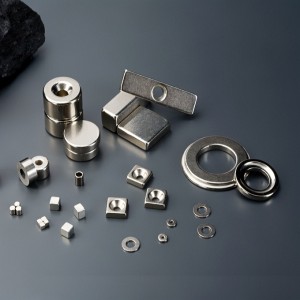
Neodymium Magnets
Introduced in 1983, the Sintered Neodymium Iron Boron (NdFeB) magnet stands as a remarkable innovation primarily composed of neodymium, iron, and boron. Its intrinsic coercivity far surpasses that of ferrite by a remarkable margin of 5-10 times, and exceeds aluminum-nickel-cobalt by a remarkable margin of 6-10 times. Remarkably, it boasts a maximum energy product that is a staggering 5-15 times greater than ferrite, firmly establishing it as the pinnacle of contemporary magnetic materials. In comparison with conventional magnetic materials, it not only exhibits exceptional magnetic properties but also stands out for its remarkable cost-effectiveness, thereby unlocking an extensive array of possibilities for magnetic material applications.
For a comprehensive understanding of our Neodymium magnets, explore our in-depth technical blog.
-
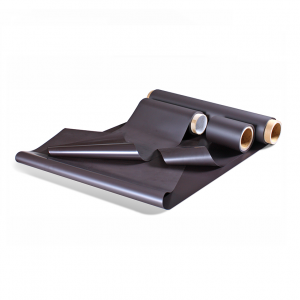
Flexible Magnets
Flexible magnets are a class of composite materials created by blending ferrite magnetic powder with synthetic rubber or plastics (CPE or NBR). They can be broadly classified into two categories: isotropic and anisotropic. With a developmental legacy spanning more than three decades, flexible magnets have evolved into an environmentally friendly, lead-free material option.
One of the hallmark attributes of rubber magnets is their remarkable flexibility and resilience. They exhibit the unique capability to be effortlessly folded, twisted, or shaped without sustaining damage or experiencing a significant degradation in magnetic performance. Additionally, these magnets offer exceptional machinability, readily accommodating conventional manufacturing processes like drilling, punching, cutting, die-cutting, and more.
-
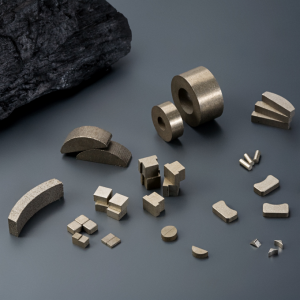
Samarium Cobalt Magnets
Sintered Samarium Cobalt (SmCo) magnets are a highly sophisticated magnetic material composed primarily of samarium, cobalt, and select rare earth elements. It can be categorized into two main variants based on the proportion of its constituent elements: SmCo5 and Sm2Co17. As second-generation rare earth permanent magnets, SmCo magnets stand out for its exceptional magnetic properties, combining a notably high magnetic energy product and dependable coercivity.
What truly sets SmCo apart is its remarkable temperature resilience, a characteristic that surpasses other rare earth magnetic materials. In comparison to Neodymium Iron Boron (NdFeB), SmCo magnets are particularly well-suited for operating in high-temperature environments, comfortably exceeding 200°C. Furthermore, these magnets exhibit an inherent resistance to corrosion and oxidation, often obviating the need for additional protective coatings.
